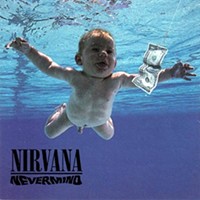Tomorrow, Nirvana's Nevermind turns twenty years old, leaving Gen Xers questioning where their lives have gone, just as they questioned where their lives were going to the strains of Smells Like Teen Spirit.
While Nevermind marked a victory for the underground in a stellar year of albums, there were plenty of releases that might have been just as ground-breaking as Nevermind had they not been eclipsed by the grunge explosion in Seattle that fall.
Nirvana's success has always been associated with a weariness for the fluff of the 1980s in light of the first U.S. war in Iraq, a bleak economic outlook, and the uncertainty of living in a world in which the enemies of the past fifty years had fallen. We weren't quite sure who we might battle next. Maybe ourselves, composed of uncertainty, apathy, anger and repressed pain that we'd covered in 1980s glitz.
Kurt Cobain, Krist Novoselic, and Dave Grohl weren't the only artists expressing these sentiments. And while they expressed them well, so did others who didn't have the luxury of an unlikely DGC Records deal and the support of a record industry looking for change.
These nine albums were released within months of Nevermind. They all sound different and utilize different styles to tell the same story Nirvana conveyed. They all might have been the impetus for 1991's music revolution under different circumstances.
9. Fugazi - Steady Diet of Nothing If it weren't for Fugazi's staunch anti-record industry stance, Steady Diet of Nothing might have been their Nevermind. Not that Fugazi would have wanted that level of success.
Released in July, the D.C. band's second album had all the rage of Nirvana's, but with a more political stance. The sparse production, done by the band, goes heavy on intricate guitar work that hints at the pop hooks of that other band, particularly on "Long Division".
A year later, Fugazi re-recorded the follow-up album, In On the Kill Taker, because it was dissatisfied with Steve Albini's production of the first recording. The next year, Albini would produce Nirvana's In Utero.
8. The Pixies - Trompe le Monde As Nirvana entered, one of its biggest influences exited. The Pixies released its final album, Trompe le Monde, the day before Nevermind. Pioneers of the quiet-loud-quiet song structure, which Kurt Cobain admits he "ripped off" when writing Nevermind. The Pixies went balls-out loud on its final recorded work. Tensions in the band, particularly between singer/guitarist Black Francis and bassist/vocalist Kim Deal, fueled an angry work filled with sarcasm and screaming. They toured behind the album until Francis disbanded them in 1993. Despite the bad ending, the band reunited a decade later and continues to tour.
"U-Mass" from Trompe le Monde is a riotous anthem against apathy, with Black directing snarling sarcasm at his alma mater, an outward anger instead of Nirvana's inward-looking pained response to an apathetic society.
7. Pavement - Slanted and Enchanted Seven months after Nevermind, an embryonic version of Pavement released its first full-length album after years of tinkering in the studio as an on-again, off-again recording project led by Stephen Malkmus and Spiral Stairs. They added musicians as they recorded the album.
Cassettes of Slanted and Enchanted started circulating a year earlier. Pavement maintained this indie integrity for their decade-long career, which likely prevented its hook-filled songs and Malkmus' blase' vocals from reaching a wider audience that would have embraced the band's melodic lo-fi fuzz.
Like the Pixies, Pavement reunited ten years after their breakup for a reunion tour in 2010.
6. My Bloody Valentine - Loveless Loveless is as richly orchestrated and lush as Nevermind is barren and loud. Kevin Shields of My Bloody Valentine spent over two years creating layers of sound so expensive it almost bankrupted Creation Records. Call it the anti-Nevermind -- ethereal and plush with blasts of tremelo bar-fueled guitar creating an army of sound.
Despite the differences, Shields and Nirvana used the same DIY ethos. Shields used very few effects, instead finding methods to manually create distortion. The vocal mix was kept low, floating above the massive whirlpool of feedback.
The record label dumped My Bloody Valentine upon the album's release. Loveless received good reviews but low sales. Shields became reclusive, releasing little in the past twenty years even as his masterpiece influenced bands like Nine Inch Nails and Smashing Pumpkins.
5. Teenage Fanclub - Bandwagonesque The U.S. was ready for the next wave of British pop, with the likes of Jesus Jones and EMF seeing commercial success in the summer of 1991. It could have been a full-on British takeover by the time Scotland's Teenage Fanclub released Bandwagonesque in November, had its sweet harmonies and shimmery guitars not been drowned out by Nevermind.
Pop perfection in the tradition of Big Star and the Beach Boys, Bandwagonesque was more challenging than what was being produced by Teenage Fanclub's U.K. counterparts. While it might not have seen American chart success, it made up for it in accolades, being called the best album of the year by many critics. It paved the way for mid-'90s pop acts to take over once listeners had grown weary of the bombast of grunge.
Teenage Fanclub has continued to record and tour. In 2006 they performed Bandwagonesque in its entirety at shows in London and Glasgow.


